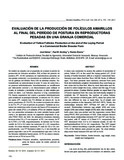Mostrar el registro sencillo del ítem
Evaluación de la producción de folículos amarillos al final del período de postura en reproductoras pesadas en una granja comercial
| dc.rights.license | http://creativecommons.org/licenses/by-nc-sa/3.0/ve/ | |
| dc.contributor.author | Gámez, José | |
| dc.contributor.author | Hocking, Paul M. | |
| dc.contributor.author | Álvarez, Ramón | |
| dc.date.accessioned | 2011-04-05T16:13:13Z | |
| dc.date.available | 2011-04-05T16:13:13Z | |
| dc.date.issued | 2011-04-05T16:13:13Z | |
| dc.identifier.issn | 0798-2259 | es_VE |
| dc.identifier.uri | http://www.saber.ula.ve/handle/123456789/32781 | |
| dc.description.abstract | Se realizó un estudio con el propósito de evaluar el patrón de producción de folículos amarillos (FA) al final del periodo de postura (PP, 23-40 semanas) en reproductoras pesadas en una granja comercial. Los muestreos se realizaron sobre 4 lotes de gallinas del híbrido Ross 308 de distintas edades. Semanalmente se seleccionaron al azar 10 aves de cada lote y se pesaron individualmente. Inmediatamente se sacrificaron por dislocación cervical y se diseccionaron para extirpar el ovario, el oviducto y recolectar el huevo, si éste estaba presente en útero. Los folículos mayores a 0,5g, considerados FA, fueron separados del ovario y pesados individualmente para establecer la jerarquía folicular, el número de: FA, folículos pares (FP, cuando dos FA diferían en menos de 1g de peso), posiciones (P, FA-FP). Se evaluó la relación del número de FA, FP y P con el período de postura. También se evaluaron las relaciones entre el peso del huevo (PH) respecto al peso del ovario (PO) y el oviducto (POv) de manera separada. Los promedios semanales de cada variable fueron graficados y se ajustaron curvas de regresión empleando la opción PROC REG del SAS. Se obtuvieron relaciones lineales inversas entre FA y P con respecto al PP, con valores de R2 de 0,7763 y 0,7106, respectivamente. El número de FA descendió de 5,9 a 5,0 entre las semanas 23 y 40, respectivamente. En estas mismas semanas, P varió de 5,8 a 4,9, respectivamente. Los FP fluctuaron entre 0 y 2 sin describir un patrón específico con el PP, encontrándose que solo 7,6% de los folículos obtenidos fueron pares. El PH no estuvo relacionado ni con el PO ni con el POv. | es_VE |
| dc.language.iso | es | es_VE |
| dc.rights | info:eu-repo/semantics/openAccess | |
| dc.subject | Folículos amarillos | es_VE |
| dc.subject | Reproductoras pesadas | es_VE |
| dc.subject | Peso de huevo | es_VE |
| dc.subject | Peso de ovario | es_VE |
| dc.subject | Período de postura | es_VE |
| dc.title | Evaluación de la producción de folículos amarillos al final del período de postura en reproductoras pesadas en una granja comercial | es_VE |
| dc.title.alternative | Evaluation of yellow follicles production at the end of the laying period in a commercial broiler breeder farm | es_VE |
| dc.type | info:eu-repo/semantics/article | |
| dc.description.abstract1 | A study was conducted to assess the pattern of production of yellow follicle (YF) at the endof the laying period (LP, 23-40 weeks) of broiler breeders (BB) in a tropical commercial farm. Samples were taken fromfour Ross 308 BB flocks of different ages. Ten hens perweek were randomly selected from each flock and individually weighed. Immediately they were hung upside down tied by their feet, killed by neck dislocation and dissected to collect weigh the ovary, oviduct and the egg, if it was present in uterus. Ovarian follicles greater or equal than 0.5g (YF)were separated from the ovary and individually weighed to establish the YF hierarchy, the number of yellow follicles (NYF), the number of follicle pairs (NFP), when two yellow follicles are different by less or equal than 1g of weight, and number positions in the hierarchy (NP=NYF-NFP). Finally, the relationships between NYF, NFPand NP with LP wereassessed. Relationships between egg weight (EW) and ovary weight (OW) and oviduct weight (OvW) were also evaluated. In both cases data was plotted and the regression curves fitted using PROC REG procedures of SAS. Data analysis showed inverse linear relationships between NYF and NP over the laying period, with R2 values of 0.78and 0.71, respectively.The NYF decreased from 5.9 to 5.0 between weeks 23 and 40 andNpdeclinedfrom 5.8 to 4.9, respectively. The NFP ranged from 0-2 without describing a specific pattern with the PP and 7.6% of the follicles were present as pairs. No clear relationships were found between EW and OW or OvW. | es_VE |
| dc.description.colacion | 170-175 | es_VE |
| dc.description.email | alvarezr@agr.ucv.ve | es_VE |
| dc.description.frecuencia | Bimestral | es_VE |
| dc.identifier.depositolegal | 199102ZU46 | es_VE |
| dc.subject.institucion | Universidad del Zulia (LUZ) | es_VE |
| dc.subject.institucion | Universidad de Los Andes (ULA) | es_VE |
| dc.subject.keywords | Yellow follicles | es_VE |
| dc.subject.keywords | Broiler breeder | es_VE |
| dc.subject.keywords | Egg weigh | es_VE |
| dc.subject.keywords | Ovary weight and layingperiod | es_VE |
| dc.subject.seccion | Revista Científica: Producción Animal | es_VE |
| dc.subject.thematiccategory | Medio Ambiente | es_VE |
| dc.subject.tipo | Revistas | es_VE |
| dc.type.media | Texto | es_VE |
Ficheros en el ítem
Este ítem aparece en la(s) siguiente(s) colección(ones)
-
Revista Científica - 2011- Vol. XXI - No. 002
Marzo - Abril 2011


